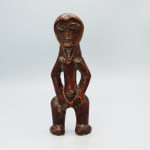Lega Iginga Figure, Nineteenth Century AD
Ivory
20.2 x 7.7 x 3.5 cm
8 x 3 x 1 3/8 in
8 x 3 x 1 3/8 in
CC.141
Further images
-
(View a larger image of thumbnail 1
)

-
(View a larger image of thumbnail 2
)

-
(View a larger image of thumbnail 3
)

-
(View a larger image of thumbnail 4
)

-
(View a larger image of thumbnail 5
)

-
(View a larger image of thumbnail 6
)

-
(View a larger image of thumbnail 7
)

-
(View a larger image of thumbnail 8
)

-
(View a larger image of thumbnail 9
)

Among the Lega people, in the forests of the Democratic Republic of the Congo, art is primarily created in the service of the semi-secret societies that permeate Lega culture. The...
Among the Lega people, in the forests of the Democratic Republic of the Congo, art is primarily created in the service of the semi-secret societies that permeate Lega culture. The most significant such society is the bwami, a society to which men and women could both belong (though women were excluded from the uppermost ranks). It taught that moral goodness begets beauty, and that knowledge is power. Comprising five levels for men, and three for women, the bwami was open to all in Lega society. Most members of the tribe join the lower orders (bwali, or the circumcision of male initiates; kongobulumbu; or ngandu for men; bombwa for women), but very few make it to the highest order, kindi. Men especially were only considered rounded members of the tribe, fully cognizant of their ancestral traditions, if they had been through all the levels.
All members of the kindi rank possess a wood, bone or ivory figure known as an iginga. They kept this iginga in a basket during bwami ceremonies, only revealing it at the moment of initiation into the kindi class. This dramatic revelation was imbued with meaning; by initiating into the higher orders of the society, the individual became pure – as signified by the polished surface of the figurine itself – and gained knowledge of the rituals and laws which governed life in the bwami. This iginga is female; she has small pyramidal breasts, and her hands frame and show off her generative organs. The emphasis here must be on fertility and birth, perhaps not a literal birth, but the rebirth of the initiate as a member of the kindi. She has a round, mask-like face with coffee-bean eyes open wide, as though in surprise, a triangular nose, and an open mouth with thick lips. Her thick neck, decorated with a V-shape, gives way to a slender torso. Her hips are wide, perhaps again emphasising fertility, and her legs akimbo, her solid legs terminating in flat feet. The ivory has achieved a red patina through years of being treated with oils and handled in ceremonies.
The artists who made objects for bwami generally worked in seclusion, and were taught through a system of apprenticeship. Figures were carved on commission from leading members of the bwami, with only limited information about the gender and material of the piece. Therefore, iginga were the result of considerable artistic freedom, as is expressed through the plethora of styles passed down to us. The resulting artwork is full of personality, expressing something of the temperament of its creator.
All members of the kindi rank possess a wood, bone or ivory figure known as an iginga. They kept this iginga in a basket during bwami ceremonies, only revealing it at the moment of initiation into the kindi class. This dramatic revelation was imbued with meaning; by initiating into the higher orders of the society, the individual became pure – as signified by the polished surface of the figurine itself – and gained knowledge of the rituals and laws which governed life in the bwami. This iginga is female; she has small pyramidal breasts, and her hands frame and show off her generative organs. The emphasis here must be on fertility and birth, perhaps not a literal birth, but the rebirth of the initiate as a member of the kindi. She has a round, mask-like face with coffee-bean eyes open wide, as though in surprise, a triangular nose, and an open mouth with thick lips. Her thick neck, decorated with a V-shape, gives way to a slender torso. Her hips are wide, perhaps again emphasising fertility, and her legs akimbo, her solid legs terminating in flat feet. The ivory has achieved a red patina through years of being treated with oils and handled in ceremonies.
The artists who made objects for bwami generally worked in seclusion, and were taught through a system of apprenticeship. Figures were carved on commission from leading members of the bwami, with only limited information about the gender and material of the piece. Therefore, iginga were the result of considerable artistic freedom, as is expressed through the plethora of styles passed down to us. The resulting artwork is full of personality, expressing something of the temperament of its creator.








